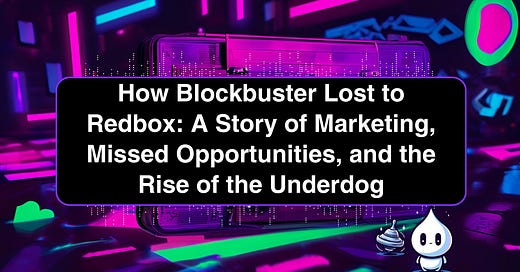You can have the best product in the world, but if you don’t know how to market it, you’ll end up like Blockbuster—crushed by a competitor who understood the game better than everyone else.
Blockbuster was the video rental giant that once ruled the world, and Redbox, the scrappy underdog that came out of nowhere to dethrone them. It’s a story of missed opportunities, bad decisions, and a competitor who played the marketing game so well that they rewrote the rules entirely.
This isn’t just a story about movies and kiosks though. It’s a story about you. Because if you’re a creator trying to build a one-person business, you’re facing the same challenges Blockbuster did. You’ve got a product (or an idea for one), but you’re struggling to get it in front of the right people.
You’re posting content, but no one’s engaging.
You’re sending emails, but they’re going to spam.
You’re stuck in a cycle of creating, posting, and hoping—while your competitors are out there eating up all the sales.
Let’s dive into the story of Blockbuster and Redbox—and how you can avoid Blockbuster’s fate with Redbox’s playbook.
The Rise of Blockbuster: A Giant Built on Convenience
In the 1990s, Blockbuster was unstoppable. They had thousands of stores, a massive inventory of VHS tapes (and later DVDs), and a brand that was synonymous with movie nights. Their blue-and-yellow stores were everywhere, and their catchline, “Make it a Blockbuster night,” was a 90s cultural slogan.
Blockbuster’s success was built on convenience. They positioned their stores in high-traffic suburban areas, making it easy for families to grab a movie on the way home. They had exclusive deals with Hollywood studios, ensuring they got new releases before anyone else. And they created an in-store experience that felt like a destination—bright lights, organized shelves, and friendly staff who could recommend the perfect movie for your Friday night.
For a while, it worked. Blockbuster was printing money. But then something happened.
The First Cracks in their Business: Late Fees and Complacency
Blockbuster’s downfall didn’t happen overnight. It started with a series of small, seemingly insignificant decisions that added up over time.
The first was late fees. Blockbuster made billions of dollars from late fees, but they were universally hated by customers. It was a classic case of short-term profits over long-term customer loyalty. People felt nickel-and-dimed, and it created a growing resentment toward the brand.
The second was complacency. Blockbuster was so focused on their stores that they failed to see the bigger picture. They dismissed Netflix’s $50 million buyout offer in 2000, thinking their mail-in DVD service was a fad. They ignored the rise of streaming, clinging to their physical stores even as the world shifted to digital.
And then, in 2002, Redbox entered the scene.
Redbox: The $1 Kiosk That Changed Everything
Redbox started as a side hustle for McDonald’s—a vending machine experiment that eventually pivoted to DVD rentals. By 2004, those bright red kiosks were popping up everywhere: grocery stores, pharmacies, and Walmarts. For just $1 a night, you could rent a movie without ever stepping foot in a Blockbuster store.
At first, Blockbuster laughed. A kiosk? Really? But Redbox wasn’t just a kiosk—it was a marketing machine.
Redbox understood something Blockbuster didn’t: convenience wasn’t just about location. It was about simplicity, speed, and value. While Blockbuster was charging $4 for a rental and slapping customers with late fees, Redbox offered $1 rentals with no late fees. You could return the DVD to any kiosk, anytime. It was frictionless.
And Redbox didn’t stop there. They used SMS campaigns to send discounts and promotions directly to customers’ phones. They created a mobile app that made renting movies even easier. They even partnered with studios to get new releases, just like Blockbuster—but without the baggage of physical stores.
While Blockbuster was stuck in the past, Redbox was rewriting the rules of the game.
The Fall of Blockbuster: A Cautionary Tale
By 2010, Blockbuster was in freefall. They tried to pivot with their own kiosks, but it was too little, too late. Redbox had already captured the market, and Netflix was dominating streaming. Blockbuster filed for bankruptcy, and by 2014, all but one of their stores had closed.
It’s easy to look back and say Blockbuster was doomed from the start. But the truth is, they had every advantage. They had the brand, the inventory, and the customer base. What they didn’t have was a marketing strategy that could adapt to a changing world.
The Lesson for Creators: How to Avoid Blockbuster’s Fate
So, what does this mean for you?
If you’re a creator trying to build a one-person business, you’re facing the same challenges Blockbuster did. You’ve got a product (or an idea for one), but you’re struggling to get it in front of the right people. You’re posting content, but no one’s engaging. You’re sending emails, but they’re going to spam. You’re stuck in a cycle of creating, posting, and hoping—while your competitors are out there eating your lunch.
But here’s the good news: you don’t have to end up like Blockbuster.
Redbox didn’t beat Blockbuster because they had a better product. They beat Blockbuster because they had a better marketing strategy. They understood their audience, created a frictionless experience, and used every tool at their disposal to hook, nurture, and convert customers.
And you can do the same.
The Solution: The 5-Step Product Marketing Blueprint
This is where my 5-Step Product Marketing Blueprint comes in. It’s the same framework Redbox used to dominate Blockbuster—and it’s the same framework you can use to grow your one-person business.
Here’s how it works:
Social Media Marketing: Hook your audience with attention-grabbing content that teases your product’s value.
Funnel Marketing: Build a system that turns casual followers into paying customers.
Email Marketing: Keep the relationship alive with personalized, value-packed emails.
Blog Marketing: Educate your audience and upsell your products with long-form content.
Product Marketing: Make your product the star by embedding upsells and value at every touchpoint.
This isn’t just a theory—it’s a proven system that works. And it’s the same system that helped Redbox crush Blockbuster.
Get the guide here →
Your Next Move
Blockbuster’s story is a cautionary tale, but it’s also an opportunity. If you’re ready to stop struggling and start growing, it’s time to take control of your marketing.
My 5-Step Product Marketing Blueprint is the solution you’ve been looking for. It’s the framework that will help you hook your audience, nurture them through the funnel, and turn them into paying customers.
Don’t end up like Blockbuster. Learn from Redbox’s playbook and start dominating your market today.
P.S. If you’re ready to build your own product marketing funnel, grab my Lead Magnet Blueprint Framework to create a freebie your audience will love. It’s the first step to turning casual followers into paying customers.














Share this post